Unless I decide otherwise, the head of Nefertiti is now finished.
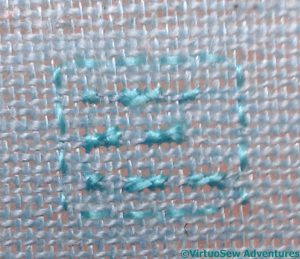
Signature Cartouche
I’ve worked my Morse Code cartouche slightly differently this time, using cross stitch for the dots, long armed cross stitch for the dashes, and counted running stitch for the frame. This works rather well, so it’s a possibility for any eventual canvaswork projects in the future.
However, in this instance it is almost completely invisible, so I may yet unpick it and rework it twice the size, with four threads in each direction instead of two.
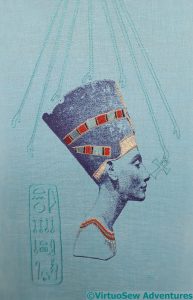
Finished Head Of Nefertiti
In the end, if you recall, I decided to work Nefertiti’s cartouche, both the hieroglyphs and the frame, in reverse chain stitch using untwisted silk.
The rays of the Aten are worked in reverse chain stitch, but using hand twisted silk.
I am a little concerned about balance and the strength of the design, but when I was playing with my photos of of the finished panel, I noticed that when I cropped the picture closely, rather than including all of the length I have stitched of the rays of the Aten, it was much improved.
That happened with the Camberwell Panel, and with Loading the Felucca, as well, so I shouldn’t be surprised.
And I really should remember to play with that sort of detail when I am mounting and finishing my embroideries!
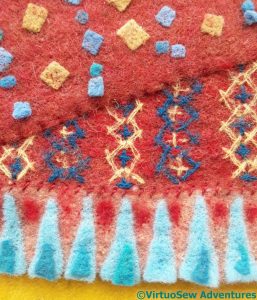
Detail OF Drapery
Having chosen my bits of drapery, I’ve stitched them together at the edges.
This means that they won’t move when I’m felting them to the background, and that I could actually cut off some of the second drapery, rather than overlapping it on the first. This will reduce the number of layers I will be felting through, which turns out to be a good idea. I don’t want any more broken needles, thank you very much!
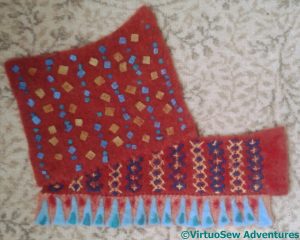
Drapery Assembled
The assembled drapery now makes a rather peculiar shape, but it gives me part of the background for my princesses, and a basis for any further embellishment I may feel is necessary.
However, as I was contemplating that eventual embellishment, I found another source picture and now I have to do a little more thinking.

Trials For Cartouche
There were many false starts when I came to work on the cartouche. The fabric is under such tension, in order to work the metal and silk stitches, that it’s hard not to create something that looks very fragile and wispy.
Here you see stem stitches, back stitches, straight stitches, chain stitches of different lengths, some worked using the same twisted thread I used for the rays of the Aten, and some in untwisted thread of the same thickness.
And I didn’t like any of them.
In fact, I ended up doubling the thickness of the thread, but not actually twisting it. This creates a more definite line, and using reverse chain stitch throughout maintains the sense of continuity with the rays of the Aten.
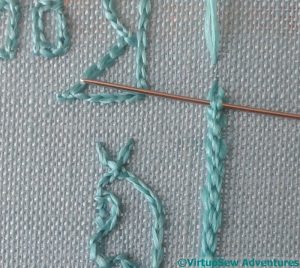
Trial Hungarian Braided
Once I had finished the hieroglyphs, I had to work the frame of the cartouche, and guess what – false starts here as well.
I was rather saddened that among the stitches tried was one of my favourites, Hungarian Braided Chain Stitch, and that, like several others, ended up being sliced out with a penknife. A rather nice penknife with a mother of pearl handle, from a vintage sewing set, but it’s frustrating to dismiss a favourite stitch, even when it’s because you don’t think it works in the context.
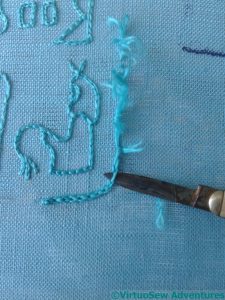
There was a lot of this!
After much to-ing and fro-ing, and a good few “ouches” from my recalcitrant sub-scapularis muscle, I finally got the cartouche finished.
I’m not entirely sure I like the finished result, so it is sitting in the living room, being stared at.
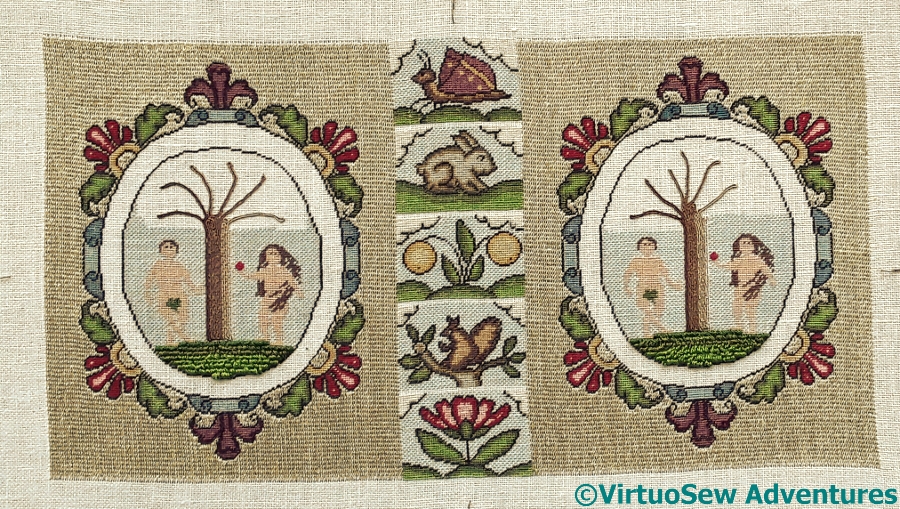
More Progress On Eve
Now I’ve got Eve out again, it’s fairly romping away, which means I genuinely have progress to show for Meredithe’s “17 UFOs in 2017“. At least, it is romping away when you consider that everything has to be done twice…! The second hillock took a couple of afternoons (I try not to work at the frame for too long at a time, in case it makes the shoulder worse again!), and then I got started on the trees and their branches.
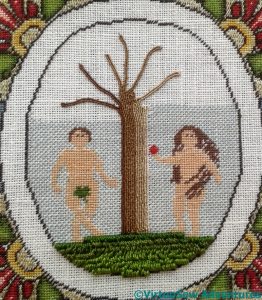
Trunk And Branches
The trunk and branches are of couched silk gimp. The kit included four different colours of gimp, with the accompanying Soie Ovale, for couching, and each colour is couched as a single length. It’s expensive stuff, and you end up using three or four inches at each end for plunging and finishing off. Most of the branches will be covered by the foliage, also in couched gimp, but I’m pausing for a moment to consider whether I want to fill in more of the sky.
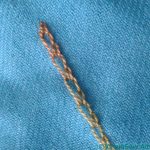
Pashmina
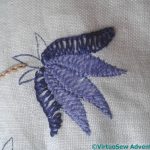
Lilac Flower
And as if that weren’t enough, I’ve also finished the gold border on the Nefertiti Shawl, and made a start on the four lilac flowers for the travelling project!
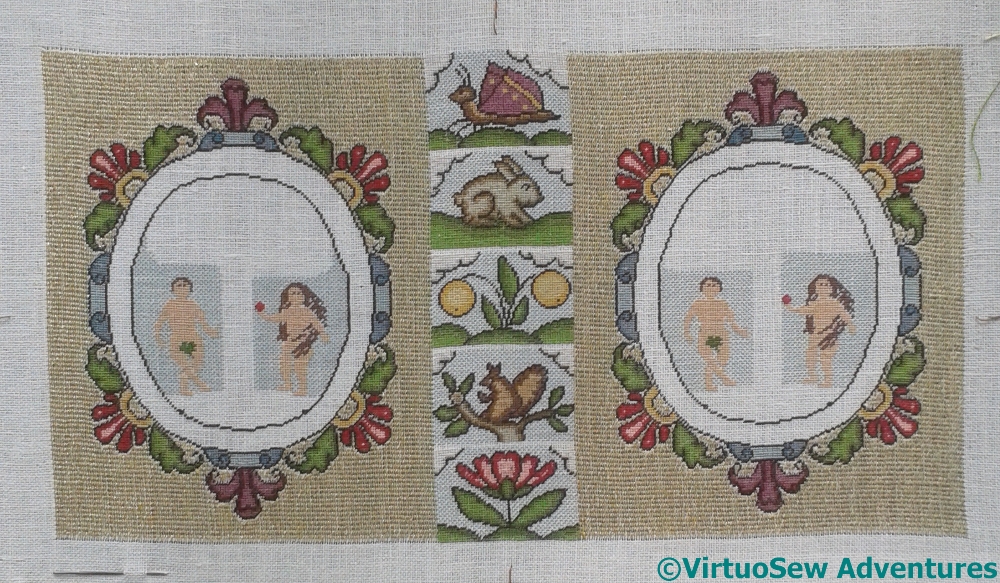
Gold Stitching Done
Those of you who follow me on Twitter or Instagram will have seen some rejoicings over the weekend. I have been working on the gold stitched background for the polychrome tent stitch for what seems like forever, but in fact it is less than a year – I began the Elizabethan Ground Stitch in October of last year. A serious shoulder problem interfered with my work at my floor frame at one stage, and then I was all taken with with my ideas for the Head of Nefertiti, so it was only recently that I got back to it. And now I have finished that laborious stage, and I can move on to the more complex and intriguing techniques which were the whole reason for taking the course.
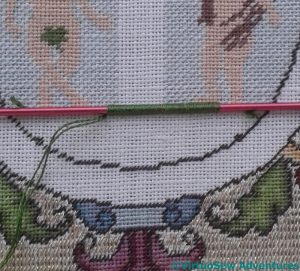
Starting The Hillocks
For instance, this one. Tricia describes this as a variation on Velvet Stitch, worked in silk thread over what I presume is a fine double ended knitting needle. It makes a perfect spacer for the pile of the stitch, anyway, and arrived with all the other bits and pieces.
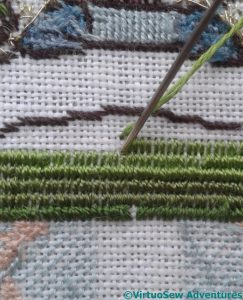
Better Worked From The Back
Tricia tells us to come up through the already occupied hole, to avoid pulling the thread through to the back and reducing the pile. I went a step further and worked it from the back, ensuring that I kept the stitch neat and the stitching going up through the right holes!
I must admit I enjoyed this, simple, and straightforward, but with just enough challenge to keep me awake and alert.
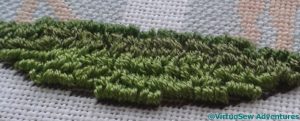
A Sideways View
And here is the first hillock, finished and fluffy. It looks as though it would be beautifully soft underfoot, doesn’t it!
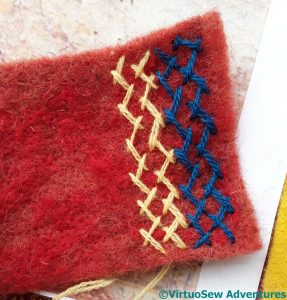
Second Drape – First Trial
For my next drapery experiment, I began by using the embellisher to add some of that divided felt onto another piece – do you see that the red is in patches, a dark pink (the background) and a rather brighter scarlet? That worked well, I think, as it has warmed up the colour, and made it more interesting.
I had decided that I would stitch a pattern and then use the embellisher to make it blend in a little more, but once I’d worked this pattern of herringbone stitch stripes, I sat back, stared at it, and said “No”.
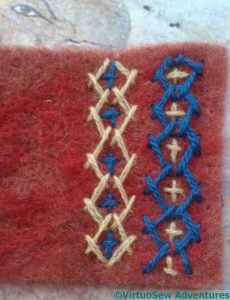
Second Drape – Much Better
So the second pattern I tried was a little more complex. It’s still worked largely in herringbone stitch, and the colours are the same, but this time I’ve reversed the second row to create a series of lozenge shapes, which could then be filled in, after a fashion, with little upright cross stitches.
I liked this much more, so I decided to go with this pattern.
Although, of course, I was referring to the picture that was my original spacing, that red is very reminiscent of Persian carpets, and the combination with blue and yellow is one which we still find in widespread use.
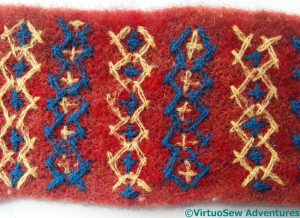
Second Drape Needlfelted
The next stage was to use the embellisher again. To begin with, I covered the stitching with a layer of net, and worked an initial pass of small circling movements, up and down each stripe. Then I removed the net and kept going.
As you can see, the stitching is almost melting into the background. Certainly it’s a more convincing representation of a piece of fabric than my first piece of drapery, although I will be using both.
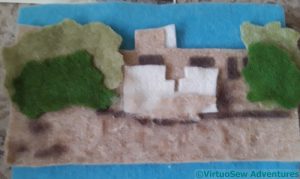
Dig House Cut Out
I’m continuing to experiment with my embellisher, trying to learn new tricks.
I’ve found a photo of the Dig House from a different view to the previous one I tried, and cut out some pieces of felt to represent the trees and the various pieces of building. It’s not going to be a very accurate representation, because, firstly, my cutting wasn’t as accurate as it could have been, and second, I’ve found that needlefelting doesn’t always go to plan.
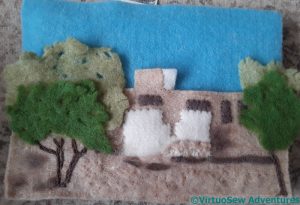
Dig House Preparation
That said, a bit of stitchery helps to keep the pieces at least approximately in place.
I felt the felt of the trees looked a bit too solid, and snipped holes in it, snipped the edges, and then tugged and tweaked at it to open up the fabric.
Then I started to use my embellisher. And oh joy, a needle broke! I changed the needle plate and slowed down a bit after that. It turns out that three layers of even this fairly light felt are a bit much for the machine.
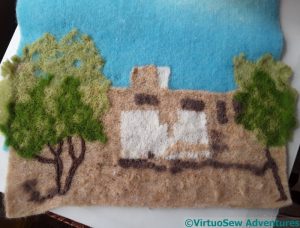
Dig House Needlefelted
However, after much slow and careful embellishing, I have this.
The trees look much better now, with the edges and the holes satisfactorily destroyed and battered around the edges. The various layers of felt are melting into one another and flattening together.
This should at least provide me with an interesting basis for further stitched details!
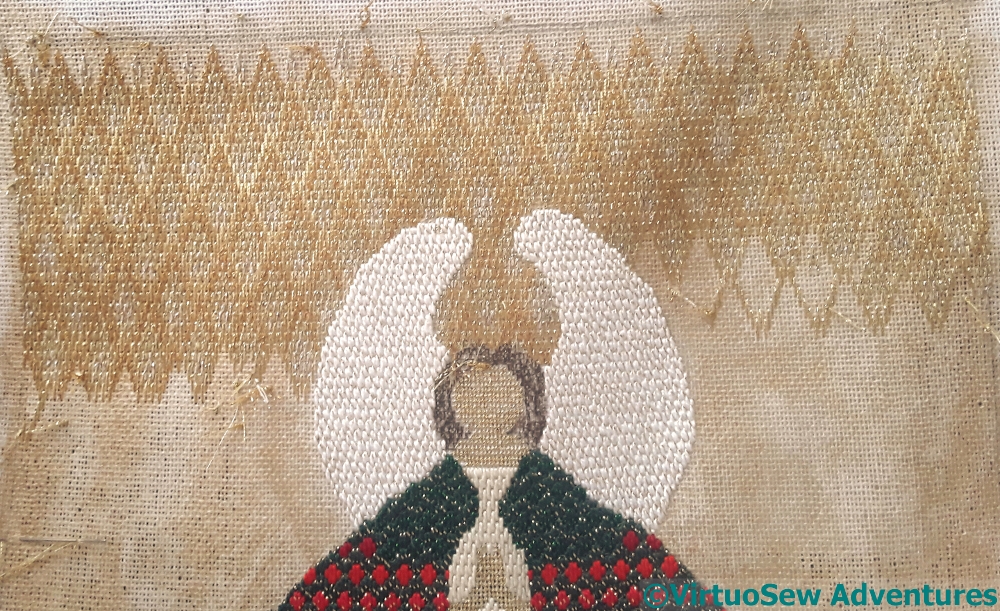
Progress on the Christmas Angel
You may recall that a very long time ago I listed some projects I wanted to work on this year, prompted by Meredithe at Pomegranate and Chintz and Anne at Frayed At The Edge. Mereditithe’s most recent post for the challenge is here.
Then the Head of Nefertiti swept into my head and my hands and took almost all my brain power and stitching time, and Nothing Happened.
Well, something has now happened. I’ve had the Christmas Angel sitting in the corner of the living room waiting to be noticed, and a little while ago, I got to a natural Stop and Think point with my other projects.
So I have made a start on the background. I’m using metallic machine thread, two strands for the rough, textured threads in the centre of each cell, and three strands, one of each of three shades for the framework. It’s beyond fiddly and flyaway, and I’ve even bought some Thread Heaven to see whether it helps (a bit, maybe not quite as much as I hoped).
All that said, I think it is going to look rather splendid when it is finished. The idea is that it should be somewhat reminiscent of an icon painted on gold leaf. Some of them have a sort of engraved “diaper pattern” effect, and I hope that the diamond flame bargello pattern will do the job.
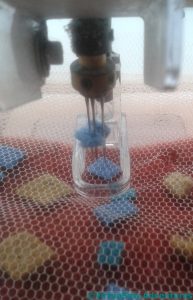
Not Quite According To Plan
The idea of using the netting is that it does not become caught up in the embellished fabric, and that it prevents bits of embellishment from becoming caught up on the needlehead and generally misbehaving.
As you can see, that sometimes doesn’t work quite as well as one might wish! Fragments can, and do, work themselves through the holes torn in the netting by the embellisher’s needles, and then jump with alacrity onto the needles, where they whizz up and down before the bemused eyes of the person operating the machine, causing no little apprehension as they do it!
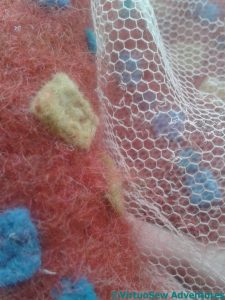
Carefully Unpeeling
There’s something else that doesn’t quite go to plan, as well. The netting does indeed become somewhat enmeshed with the felt.
As you can see, my little additions are by no means felted into the backing piece, but I’m already having to be very careful to peel off the netting, and if I had done much more with the embellisher, I might never have got the netting off at all!
I think it would be fair to say that I don’t really have anything like a real understanding of the effect of the embellisher on particular materials or combinations of materials. I’ve several more projects in mind so I’m sure my understanding will grow, but even by my standards, this is a venture into the unknown.
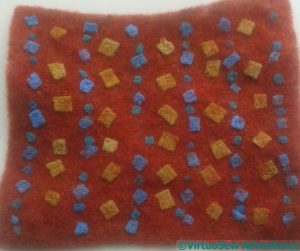
Embellishment Needlefelted
You can see that some of the pieces moved, and some never attached themselves at all. The pattern is distinctly higgledy-piggledy, and the elements aren’t equally firmly attached.
That said, I’ve managed to create something that has the warm red and the flashes of blue and gold, and although it isn’t the same pattern as the one in the fresco, it is certainly reminiscent of it.
I’m going to try another method entirely for a second section of drapery, and see whether that creates the effect I want.
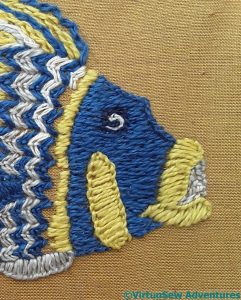
Face Of Tilapia
There was a pause after I got the dorsal fin done. His lips and gill markings, and the pectoral fin, are all worked in blanket stitches, nesting them to outline the shapes in some cases and putting the edge where I wanted the firmer line in others.
I don’t have a dark enough linen thread for the dark of his eye, so the chain stitch spiral is of linen (the white) but then the dark is the navy silk perle I used on Nefertiti’s headdress. It works pretty well, I think. It looks as though he’s rolling a beady eye to watch someone he has his suspicions of!
I decided not to do anything too complicated for his head – simple irregular brick stitch. I didn’t want to split the threads, but I did my best to create a smooth surface.
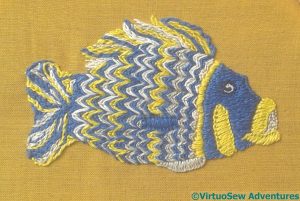
Finished Glass Nile Tilapia
When it came to the dragged stripes on the body, there was another pause. I knew what I should probably use, but I had to persuade myself that there wasn’t anything better. The last time I used stacked fly stitches (the fourth panel of the Persian Fantasy, which I did about twenty years ago and blogged about when I started blogging in 2010) the wretched things nearly drove me up the wall!
I think the fly stitches were better than other choices – although one of these days I may take the combed pattern as the inspiration for some Bargello work. That said, I’m not sure I like my Fishie as much as I expected to. His tail fin took some wrestling with, and doesn’t have the “flow” I was aiming for. It’s very possible that in a few months he’ll be fished out (sorry!) and reworked somewhat.



























